Porto-North-Portugal.com
The best independent guide to north Portugal
Porto-North-Portugal.com
The best independent guide to north Portugal
Ponte de Lima, Portugal; an independent tourism guide for 2025
As Portugal's oldest chartered town, Ponte de Lima is a place where history feels alive, set against the serene backdrop of the slow-flowing Lima River. For centuries, this has been one of northern Portugal’s most important river crossings, a role that has blessed the town with a deep and fascinating heritage.
The town's focal point is its stunning medieval bridge, built upon Roman foundations, which has gracefully spanned the river for nearly a thousand years. Beyond it, a delightful maze of cobbled lanes reveals a beautifully preserved historic centre, where ancient manor houses stand alongside Gothic churches and sunny plazas lined with traditional buildings. This remarkable collection of historical sights gives Ponte de Lima an undeniable charm.
Ponte de Lima mantiene un ritmo tranquilo y pausado, donde la vida se despliega en sus jardines a orillas del río y en su animado mercado quincenal, uno de los más antiguos de todo Portugal. Es un destino que ha permanecido prácticamente al margen del turismo de masas, conservando un carácter profundamente auténtico.
La villa es también el punto de partida ideal para adentrarse en los paisajes verdes y frondosos del Miño, una región famosa por sus viñedos de Vinho Verde y por la belleza salvaje del cercano Parque Nacional de Peneda-Gerês.
Esta guía te dará toda la información que necesitas para descubrir Ponte de Lima y te ayudará a planificar tu visita a uno de los destinos más encantadores del norte de Portugal.
Highlights of Ponte de Lima
Ponte Medieval - A symbol of the town, this magnificent stone bridge gracefully crosses the Lima River. Its foundations are Roman, but the structure you see today is a medieval marvel that for centuries guided pilgrims on their journey north to Santiago de Compostela.
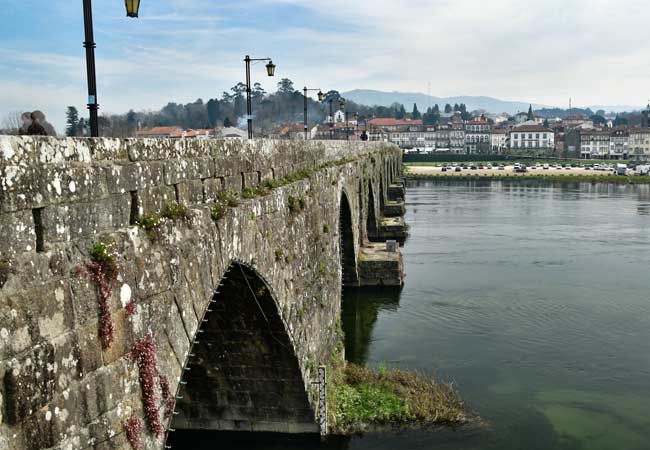
Vinho Verde - Ponte de Lima lies in the heart of the Vinho Verde region, famed for its crisp, refreshing, and lightly sparkling wine made from young grapes. It’s the perfect place to sample the local varieties that so perfectly capture the lush character of the Minho landscape.
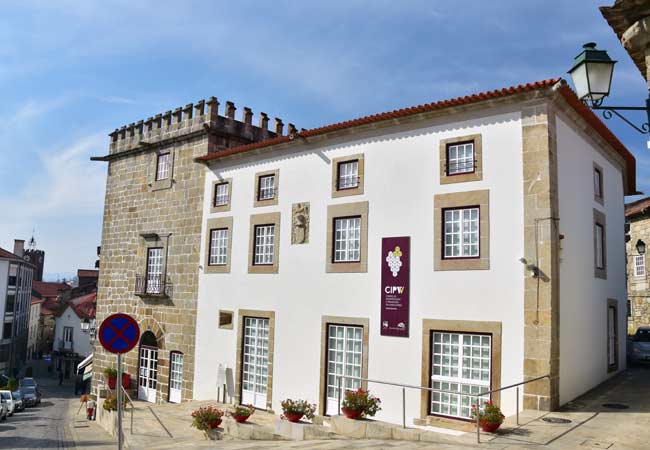
The historic centre of Ponte de Lima - Wander through the beautifully preserved medieval heart of Ponte de Lima. Discover the imposing Gothic Igreja Matriz, remnants of the ancient town walls, and the Largo de Camões, the town's charming central plaza.
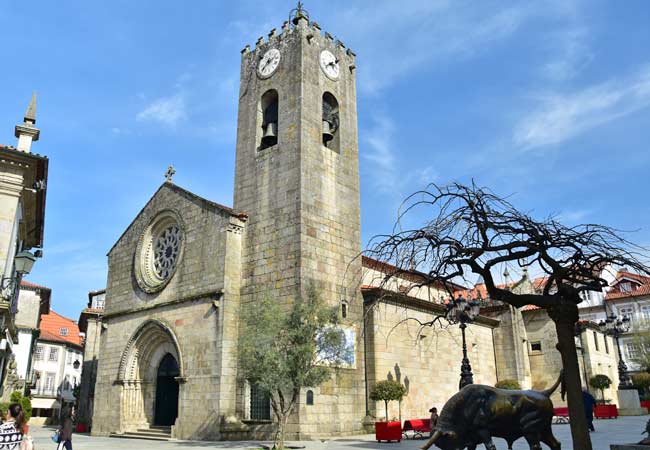
The Festival Internacional de Jardins - A stunning celebration of creativity and landscape design held on the banks of the river. Every year from May to October, the festival showcases twelve imaginative gardens created by artists from around the world, each interpreting a different annual theme. It is a vibrant and colourful highlight of the summer season.
Is Ponte de Lima Worth Visiting?
Yes, Ponte de Lima is one of the finest small towns in northern Portugal and is highly recommended for any tour of the region. It offers a fantastic combination of historical sights, a beautiful riverside setting, and a relaxed, authentic atmosphere.
The historic centre is compact, meaning its main sights can be fully explored in two to three hours. This makes Ponte de Lima an ideal stop for a half-day visit while travelling through the north.
For a longer stay, the town provides a peaceful and traditional base. It has many excellent restaurants along with charming accommodation options, and the famous fortnightly market held on the riverbanks. During the summer, its appeal is heightened by the creative displays of the International Garden Festival (May to October).
Ponte de Lima is also a centre for outdoor pursuits. Popular activities include kayaking on the Lima River, cycling the riverside eco-via, and hiking in the scenic Serra d'Arga hills.
In summary, Ponte de Lima is a delightful destination that will appeal to almost all visitors who are on holiday to Northern Portugal.
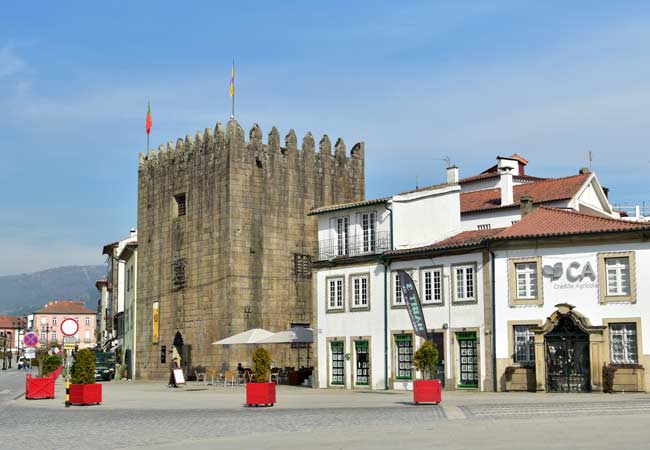
The pretty historic centre of Ponte de Lima and the Torre da Cadeia Velha
A day trip to Ponte de Lima
Ponte de Lima is a fantastic destination for day trip, but it is only a small town and can fully be seen within two hours of sightseeing.
The day trip could be extended by visiting the gardens of the Festival Internacional de Jardins or taking a pleasant walk along the river. If you have a car, the day trip could include the pretty village of Ponte da Barca, which is 20km to the east.
A day trip to Ponte de Lima is possible using public transport when based in Viana do Castelo (32km away), but there is no direct public transport from Porto, so a car is needed.
Below is a suggested tour of Ponte de Lima, which begins and ends at the main bus stop on the Praça da República.
Sights along the route: 1) Praça da República 2) Estátua de Dona Teresa 3) Câmara Municipal 4) Igreja da Misericórdia 5) Torre da Cadeia Velha 6) Torre de São Paulo 7) Santo António dos Capuchos 8) Igreja de Nossa Senhora da Guia 9) Festival Internacional de Jardins (Jun-Oct) 10) Igreja de Santo António 11) Parque do Arnado 12) Museu Rural de Ponte de Lima 13) Museu do Brinquedo 14) Ponte Medieval 15) Centro de Interpretação e Promoção do Vinho Verde 16) Paço do Marquês
Note: All of Ponte de Lima's museums are closed on Mondays
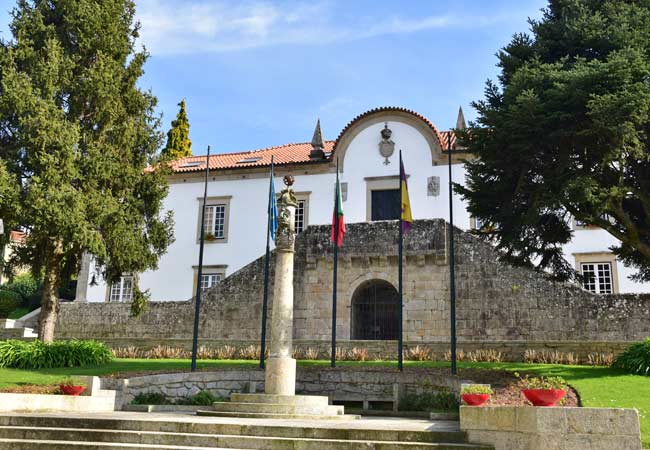
The Câmara Municipal of Ponte de Lima
A longer stay in Ponte de Lima?
Ponte de Lima is often visited as a day trip but it does make for a pleasant base from which to explore the region.
There is surprisingly poor public transport between Porto and Ponte de Lima; therefore we would recommend a stay of one night for a hassle-free visit.
The map below shows the location of hotels and rental rooms in Ponte de Lima; by altering the date to your holiday, the map will display current prices:
Ponte de Lima the oldest town in Portugal
Ponte de Lima is frequently referred to as the oldest town in Portugal. This was due to the town being given a royal charter by Queen Teresa on the 4th March 1125. This was technically three years before Portugal was established as an independent country in 1128.
A statue of Queen Teresa presenting the charter to the town stands on the Avenida António Feijó.
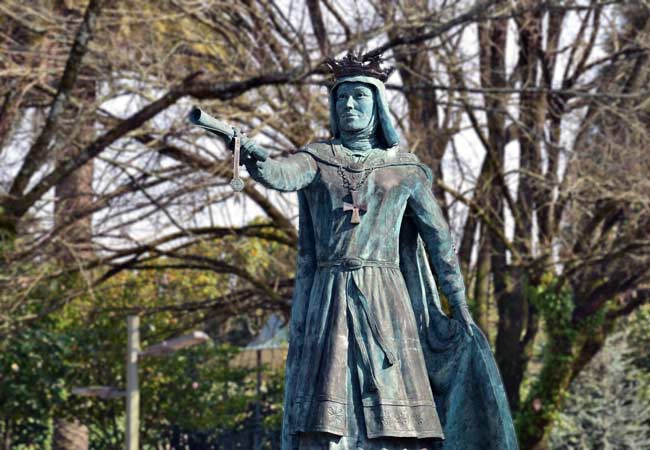
Ponte de Lima and Camino de Santiago (Caminho Português)
Ponte de Lima is one of the major towns along the Portuguese section of the Camino de Santiago (referred to as the Camino Portugués).
Ponte de Lima lies in the middle of two of the most challenging sections of the route. The section from Barcelos to Ponte de Lima is one of the longest at 35km, while Ponte de Lima to Rubiães is shorter (at 17km), but passes through the Serra D'Arga hills.
Ponte de Lima is a great destination for a longer stop and has a good selection of shops, hotels and restaurants. The town is also used to a constant flow of weary walkers. If you are planning a location for a rest day along the Camino Portugués, Ponte de Lima is a good choice.
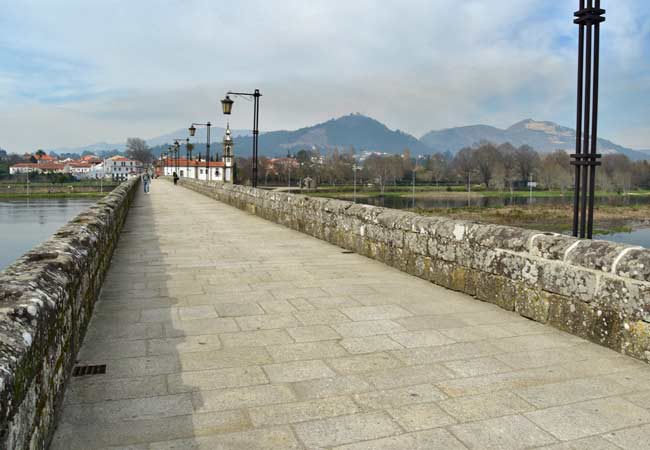
The Caminho Português route crosses the medieval bridge
The Ponte Romana and the Ponte Medieval bridge
The most famous attraction of Ponte de Lima is the bridge that spans the Lima River. There are actually two sections of this bridge; the Ponte Romana and the Ponte Medieval.
The Ponte Romana is the much older bridge, being constructed by the Romans in the first century. This bridge spanned the Lima River when it flowed further north, and today the seven arches of the bridge cross the field in front of the Santo António church.
The Ponte Medieval was constructed in 1370 and was part of a larger project to improve the defences of the town, which also included the construction of the town walls and towers (such as Torre da Cadeia Velha).
The bridge consisted of seventeen arches (two are buried today) along with defensive battlements. These stone fortifications were removed during the 17th century and used as building materials in the town's houses.
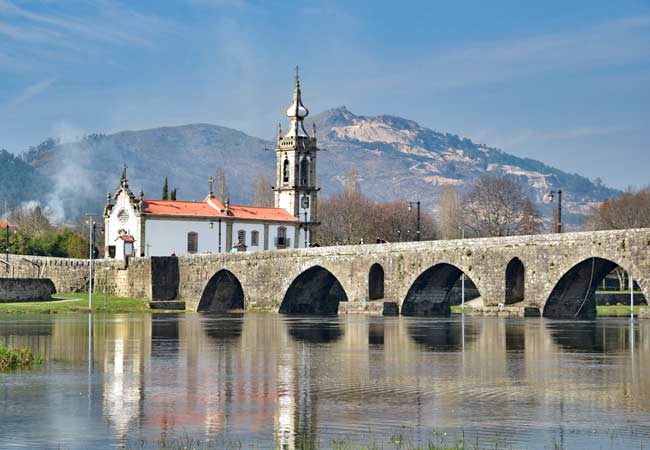
The Igreja de Santo António church stands on the northern side of the bridge
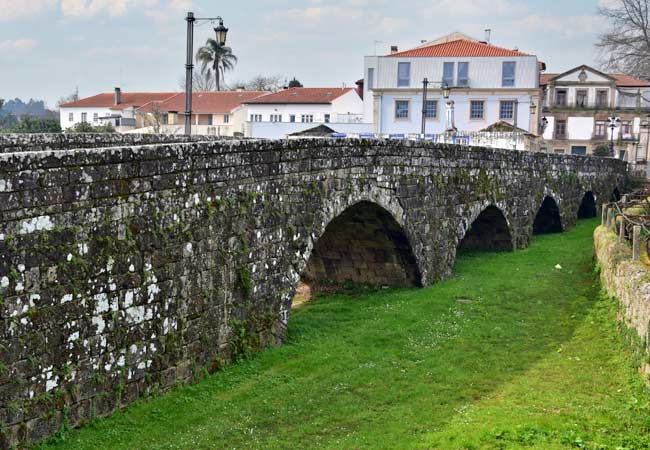
The Ponte Romana, where the Rio Lima used to flow during the Roman era
The Lethe River and the fearful Romans
During the early Roman rule of Portugal, they believed that the Rio Lima was the fabled Lethe River, one of the underworld rivers of Hades. They feared that anyone who entered the river would lose their mind to Oblivion.
General Decimus Junius Brutus was forced to test this superstition in 138BC, during a campaign into northern Spain. He crossed first on his horse and then had his men shout their names out as they waded through the water, so as not to lose their minds to "Oblivion".
This first crossing of the Lima River is commemorated by the Roman statues on either side of the riverbanks.
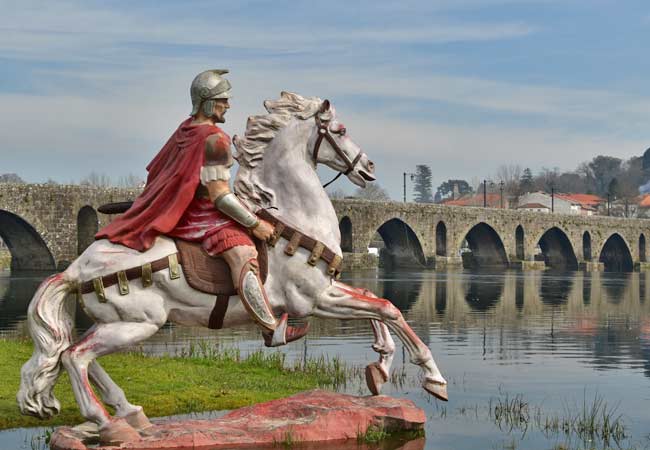
The statue of Brutus commanding his troops to cross the Rio Lima
Ponte de Lima International Garden Festival
The Festival Internacional de Jardins is a gardening competition that is hosted every summer between the last Friday of May until the end of October.
Gardening teams from around the world apply, and the top 12 designs are invited to be planted for the summer season. The theme for 2023 is "Gardens and Climate Change".
The gardens are varied and pretty with many styles and plants. Also found within the festival site is a swimming pool. Further information can be found on their website: www.
Travel information
Ponte de Lima is designed to be driven to, and there is ample parking in the two large car parks. During the low season these carparks are popular with campervans.
There is surprisingly poor public transport to Ponte de Lima; there are no rail connections and bus services are very limited, even from Porto. There are multiple bus companies offering services from Porto to Ponte de Lima, but each only has infrequent departures, the bus companies are:
/www.ovnitur.pt/expresso.php
www.avminho.pt/horarios
www.rede-expressos.pt/en/
www.barquense.com (from the airport)
(links open new tabs)
It is much easier to travel from Viana do Castelo to Ponte de Lima by public transport and the number of departures means that the town can be visited as a day trip. The bus route is operated by Auto Viação do Minho (AVMinho), and a link to their website (and timetable) can be found here:
www.avminho.pt/horarios
(link opens new link)
The main bus stop in Ponte de Lima is on the Av. António Feijó (GPS: 41.76658, -8.58196).
If you've found our content valuable, we'd welcome your support.
The digital publishing landscape has evolved significantly. As a small independent publisher, we face growing challenges. Search engines increasingly favour paid content over organic results, while AI-generated content often reproduces original work without attribution.
To support our work, please consider bookmarking this page (press Ctrl + D) for quick access. If you find an article helpful, we'd be grateful if you'd share it with friends on social media.
For specific questions, please see our Reddit community at r/LisbonPortugalTravel.
Should you notice any outdated or incorrect information, please contact us at [email protected]
Thank you for helping us continue to provide valuable content in an increasingly challenging digital environment.























